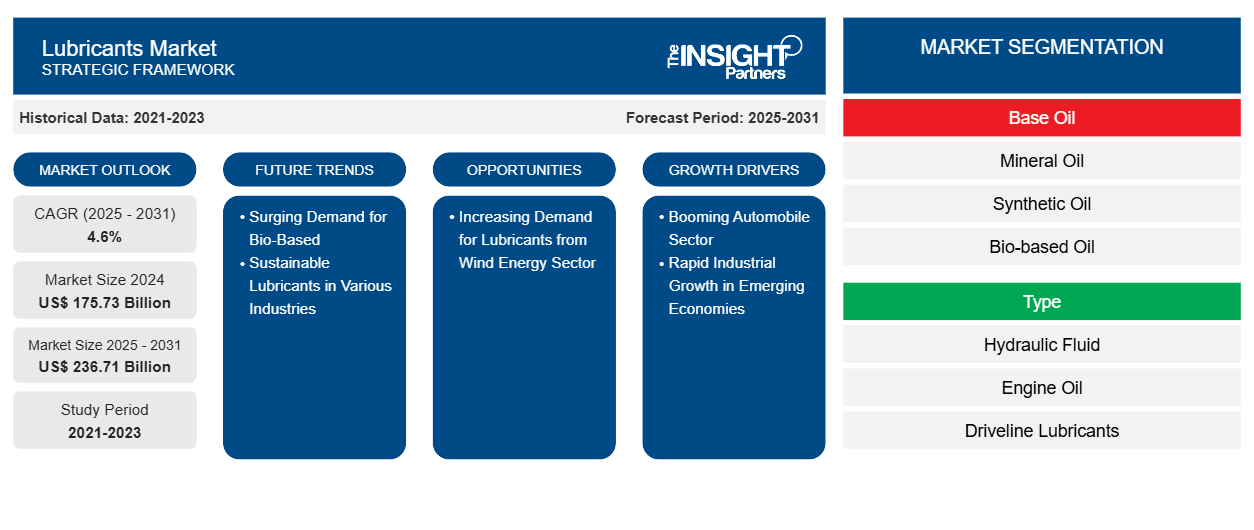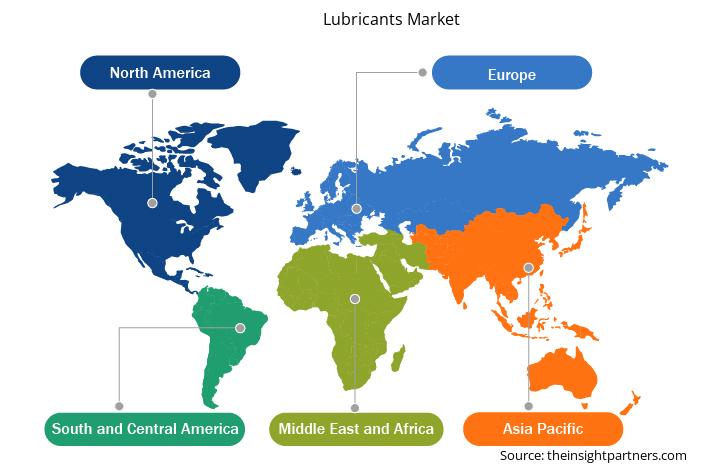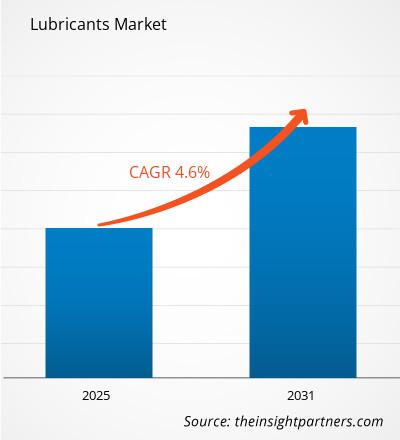预计到 2031 年,润滑油市场规模将从 2024 年的 1757.3 亿美元增至 2367.1 亿美元;预计 2025-2031 年期间市场复合年增长率将达到 4.6%。各行业对生物基和可持续润滑油的需求激增,预计将成为市场的主要趋势。
润滑油市场分析
全球制造商都在投资改善其供应链,以增加发展中地区的汽车销量。根据印度汽车制造商协会 (SIAM) 的数据,在印度,乘用车销量从 2022 年 11 月的约 2,409,535 辆增加到 2023 年 11 月的近 2,854,242 辆。就生产的汽车数量而言,南非汽车制造业是世界第 22 大汽车制造业,也是非洲大陆最大的汽车制造业,占 2023 年非洲大陆组装汽车的约 54% 以上。根据国际汽车制造商组织 (OICA) 的数据,2023 年巴西是南美洲和中美洲最大的轻型和商用汽车制造商和出口国。该国报告称,2022 年生产了近 230 万辆汽车。传统上,润滑剂在内燃机 (ICE) 车辆中必不可少,它们可以减少摩擦、防止磨损并帮助管理发动机热量。然而,电动汽车的兴起为润滑油市场带来了新的活力。尽管电动汽车没有传统发动机,但其变速箱、发动机和其他传动系统部件等多个部件仍然依赖润滑油。因此,不断发展的汽车行业正在加速对润滑油的需求,从而提高车辆性能和使用寿命。
润滑油市场概况
全球各国都在经历工业化,导致多个行业的机械设备使用量激增。制造业、建筑业、采矿业和农业等行业严重依赖需要润滑剂才能实现最佳性能和使用寿命的机械。工业活动的增加以及建筑业和农业行业的增长预计将增加对润滑剂的需求。
定制此报告以满足您的需求
您可以免费定制任何报告,包括本报告的部分内容、国家级分析、Excel 数据包,以及为初创企业和大学提供优惠和折扣
润滑油市场:战略洞察

-
获取此报告的关键市场趋势。这个免费样品将包括数据分析,从市场趋势到估计和预测。
润滑油市场驱动因素和机遇
新兴经济体工业快速增长推动市场增长
石油和天然气、纺织、采矿和冶金、发电、造纸和纸浆、化学品和石化产品、农业、制造业、食品和饮料以及制药行业使用多种类型的润滑剂,例如矿物和合成润滑剂、油脂、压缩机油和切削液。根据 Trading Economics 在 2024 年 11 月发布的数据,中国工业产值增长了 5.4%。随着采矿业的强劲增长,对润滑剂的需求也随之增加,这主要是由于采矿作业中大量使用重型机械。这些机器是矿物开采和加工不可或缺的一部分,需要有效的润滑才能确保平稳运行、减少磨损并延长使用寿命。采矿活动以恶劣的作业条件为特征,给设备部件带来巨大的压力。润滑剂对于减轻摩擦、控制温度和防止腐蚀至关重要,从而提高采矿机械的整体性能和使用寿命。随着对矿物和金属的需求不断增长,推动了采矿作业的发展,由于矿业公司优先考虑其设备的维护和优化,润滑油市场也经历了相应的上升。
风能行业对润滑油的需求不断增加,为市场创造增长机会
风能是增长最快的可再生能源技术之一,在电力行业中占据着润滑油消费的潜在份额。根据 WindEurope 发布的数据,2023 年,欧洲新增风电装机容量为 18.3 吉瓦,预计 2024-2030 年新增风电装机容量为 260 吉瓦。由于该地区的几个国家正在拥抱可再生能源,尤其是风能,因此对专用润滑油的需求变得至关重要,以确保风力涡轮机的平稳运行。这些润滑油提高了利用风能的复杂机械的运行效率和使用寿命。不断扩大的风能行业需要可靠且持续的高性能润滑油供应,以减轻磨损、减少摩擦并防止风力涡轮机机械部件腐蚀。这种需求为研发开辟了道路,鼓励针对风能环境带来的独特挑战定制润滑油配方的创新。
润滑油市场报告细分分析
有助于得出润滑油市场分析的关键部分是基础油、类型和最终用途行业。
- 根据基础油,润滑油市场分为矿物油、合成油和生物基油。
- 根据类型,市场分为液压油、发动机油、传动系润滑剂、金属加工液、润滑脂、工艺油、冷却剂等。
- 就终端使用行业而言,市场细分为汽车、建筑和施工、发电、采矿和冶金、食品加工、石油和天然气、海洋、航空和其他。汽车细分市场进一步细分为乘用车、轻型商用车、重型商用车和其他。
润滑油市场份额按地区分析
润滑油市场报告的地理范围主要分为五个地区:北美、亚太、欧洲、中东和非洲、南美和中美。
预计亚太地区将在预测期内占据市场主导地位。亚太地区是汽车制造中心,大量国内外企业在该地区运营。根据中国乘用车协会发布的报告,2022 年,特斯拉公司交付了 83,135 辆中国制造的电动汽车,表明电动汽车销量与 2021 年相比有所增长。根据中国汽车工业协会的数据,2023 年中国售出约 6,000 辆燃料电池电动汽车,同比增长 72%。根据印度品牌资产基金会的数据,2023 年印度的汽车年产量达到 2590 万辆。2024 年 9 月,乘用车、三轮车、两轮车和四轮车的总产量为 2,773,039 辆。润滑剂用于发动机、变速器和差速器等汽车部件,提供润滑以减少摩擦、提高燃油效率,从而确保车辆的最佳性能和使用寿命。
中国、日本和韩国是造船业的领先国家。造船用润滑脂具有抗风化、抗腐蚀性海水、抗高压和延长船舶部件使用寿命等特性。
润滑油市场区域洞察
Insight Partners 的分析师已详尽解释了预测期内影响润滑油市场的区域趋势和因素。本节还讨论了北美、欧洲、亚太地区、中东和非洲以及南美和中美洲的润滑油市场细分和地理位置。

- 获取润滑油市场的区域特定数据
润滑油市场报告范围
| 报告属性 | 细节 |
|---|---|
| 2024 年的市场规模 | 1757.3亿美元 |
| 2031 年市场规模 | 2367.1亿美元 |
| 全球复合年增长率(2025 - 2031) | 4.6% |
| 史料 | 2021-2023 |
| 预测期 | 2025-2031 |
| 涵盖的领域 |
按基础油分类
|
| 覆盖地区和国家 |
北美
|
| 市场领导者和主要公司简介 |
|
润滑油市场参与者密度:了解其对业务动态的影响
润滑油市场正在快速增长,这得益于终端用户需求的不断增长,而这些需求又源于消费者偏好的不断变化、技术进步以及对产品优势的认识不断提高等因素。随着需求的增加,企业正在扩大其产品范围,进行创新以满足消费者的需求,并利用新兴趋势,从而进一步推动市场增长。
市场参与者密度是指在特定市场或行业内运营的企业或公司的分布情况。它表明在给定市场空间中,相对于其规模或总市场价值,有多少竞争对手(市场参与者)存在。
在润滑油市场运营的主要公司有:
- 嘉实多有限公司
- 壳牌公司
- 彭斯石油公司
- 奎克州润滑剂有限公司
- 道达尔能源公司
- 雷普索尔集团
免责声明:上面列出的公司没有按照任何特定顺序排列。

- 了解润滑油市场主要参与者概况
润滑油市场新闻及最新发展
润滑油市场的评估是通过收集来自一手和二手研究的定性和定量数据进行的,其中包括重要的公司出版物、协会数据和数据库。润滑油市场的一些发展情况如下:
- 嘉实多在英国发起了“首款汽车爱情故事”活动,以提高品牌知名度和销量。(嘉实多有限公司,公司网站,2024 年 8 月)
- Repsol 与 Tekniker 联手开发采用纳米技术的润滑剂。(Repsol,公司网站,2024 年 9 月)
- Repsol 推出了其新型润滑油包装,其中含有 60% 的再生塑料。(Repsol,公司网站,2024 年 3 月)
- 嘉实多推出了一款符合新版 ACEA 重型规格的新型 VECTON 全合成商用车润滑油。(嘉实多有限公司,公司网站,2024 年 8 月)
- 埃克森美孚扩大了美孚品牌润滑油和化工产品,重点关注优质产品创新。(埃克森美孚,公司新闻,2023 年 9 月)
- 壳牌润滑油收购了英国的 MIDEL 和 MIVOLT,增强了其电力和可再生能源领域的产品组合。 (壳牌,公司新闻,2023 年 10 月)
润滑油市场报告范围和交付成果
“润滑油市场规模和预测(2021-2031 年)”报告对以下领域进行了详细的市场分析:
- 润滑油市场规模及范围内所有主要细分市场的预测
- 润滑油市场趋势以及市场动态,如驱动因素、限制因素和关键机遇
- 详细的波特五力分析和 SWOT 分析
- 润滑油市场分析涵盖主要市场趋势、国家框架、主要参与者、法规和最新的市场发展。
- 行业格局和竞争分析,涵盖市场集中度、热点图分析、知名参与者以及润滑油市场的最新发展
- 详细的公司简介
- 历史分析(2 年)、基准年、预测(7 年)及复合年增长率
- PEST和SWOT分析
- 市场规模、价值/数量 - 全球、区域、国家
- 行业和竞争格局
- Excel 数据集
近期报告
相关报告
客户评价
购买理由
- 明智的决策
- 了解市场动态
- 竞争分析
- 客户洞察
- 市场预测
- 风险规避
- 战略规划
- 投资论证
- 识别新兴市场
- 优化营销策略
- 提升运营效率
- 顺应监管趋势






















 获取免费样品 - 润滑油市场
获取免费样品 - 润滑油市场